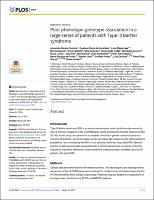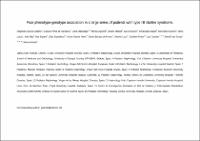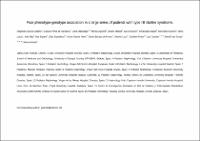| dc.contributor | Vall d'Hebron Barcelona Hospital Campus |
| dc.contributor.author | García Castaño, Alejandro |
| dc.contributor.author | Pérez de Nanclares, Gustavo |
| dc.contributor.author | Madariaga, Leire |
| dc.contributor.author | Aguirre, Mireia |
| dc.contributor.author | Madrid Aris, Alvaro Domingo |
| dc.contributor.author | Chocron de Benzaquen, Sara |
| dc.contributor.author | Ariceta Iraola, Gema |
| dc.date.accessioned | 2021-04-27T11:14:00Z |
| dc.date.available | 2021-04-27T11:14:00Z |
| dc.date.issued | 2017-03-13 |
| dc.identifier.citation | García Castaño A, Pérez de Nanclares G, Madariaga L, Aguirre M, Madrid Á, Chocrón S, et al. Poor phenotype-genotype association in a large series of patients with Type III Bartter syndrome. Wu Z-Y, editor. PLoS One. 2017 Mar 13;12(3):e0173581. |
| dc.identifier.issn | 1932-6203 |
| dc.identifier.uri | https://hdl.handle.net/11351/5912 |
| dc.description | Excretion; Human genetics; Mutation |
| dc.description.abstract | Introduction
Type III Bartter syndrome (BS) is an autosomal recessive renal tubule disorder caused by loss-of-function mutations in the CLCNKB gene, which encodes the chloride channel protein ClC-Kb. In this study, we carried out a complete clinical and genetic characterization in a cohort of 30 patients, one of the largest series described. By comparing with other published populations, and considering that 80% of our patients presented the p.Ala204Thr Spanish founder mutation presumably associated with a common phenotype, we aimed to test the hypothesis that allelic differences could explain the wide phenotypic variability observed in patients with type III BS.
Methods
Clinical data were retrieved from the referral centers. The exon regions and flanking intronic sequences of the CLCNKB gene were screened for mutations by polymerase chain reaction (PCR) followed by direct Sanger sequencing. Presence of gross deletions or duplications in the region was checked for by MLPA and QMPSF analyses.
Results
Polyuria, polydipsia and dehydration were the main common symptoms. Metabolic alkalosis and hypokalemia of renal origin were detected in all patients at diagnosis. Calciuria levels were variable: hypercalciuria was detected in 31% of patients, while 23% had hypocalciuria. Nephrocalcinosis was diagnosed in 20% of the cohort. Two novel CLCNKB mutations were identified: a small homozygous deletion (c.753delG) in one patient and a small deletion (c.1026delC) in another. The latter was present in compound heterozygosis with the already previously described p.Glu442Gly mutation. No phenotypic association was obtained regarding the genotype.
Conclusion
A poor correlation was found between a specific type of mutation in the CLCNKB gene and type III BS phenotype. Importantly, two CLCNKB mutations not previously described were found in our cohort |
| dc.language.iso | eng |
| dc.publisher | Public Library of Science |
| dc.relation.ispartofseries | PLoS ONE;12(3) |
| dc.rights | Attribution 4.0 International |
| dc.rights.uri | http://creativecommons.org/licenses/by/4.0/ |
| dc.source | Scientia |
| dc.subject | Malalties congènites |
| dc.subject | Ronyons - Malalties |
| dc.subject.mesh | Bartter Syndrome |
| dc.subject.mesh | /genetics |
| dc.title | Poor phenotype-genotype association in a large series of patients with Type III Bartter syndrome |
| dc.type | info:eu-repo/semantics/article |
| dc.identifier.doi | 10.1371/journal.pone.0173581 |
| dc.subject.decs | síndrome de Bartter |
| dc.subject.decs | /genética |
| dc.relation.publishversion | https://journals.plos.org/plosone/article?id=10.1371/journal.pone.0173581 |
| dc.type.version | info:eu-repo/semantics/publishedVersion |
| dc.audience | Professionals |
| dc.contributor.organismes | Institut Català de la Salut |
| dc.contributor.authoraffiliation | [García Castaño A, Pérez de Nanclares G] BioCruces Health Research Institute, Ciberer, Cruces University Hospital, Bizkaia, Spain. [Madariaga L] Pediatric Nephrology, Cruces University Hospital, Bizkaia, Spain. Department of Pediatrics, School of Medicine and Odontology, University of Basque Country UPV/EHU, Bizkaia, Spain. [Aguirre M] Pediatric Nephrology, Cruces University Hospital, Bizkaia, Spain. [Madrid Á, Chocrón S, Ariceta G] Servei de Nefrologia Pediàtrica, Vall d'Hebron Hospital Universitari, Barcelona, Spain. Universitat Autònoma de Barcelona, Bellaterra, Spain |
| dc.identifier.pmid | 28288174 |
| dc.identifier.wos | 000396092400019 |
| dc.relation.projectid | info:eu-repo/grantAgreement/ES/1PN/2008-20117PI09%2F90888 |
| dc.relation.projectid | info:eu-repo/grantAgreement/ES/2PN/2008-2011/PI11%2F01412 |
| dc.rights.accessrights | info:eu-repo/semantics/openAccess |

 Private area
Private area Contact Us
Contact Us









